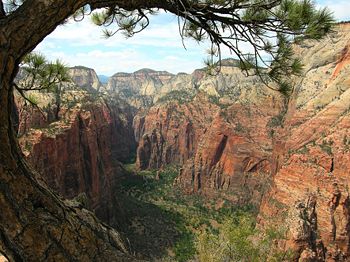Landscape
 From Citizendium - Reading time: 2 min
From Citizendium - Reading time: 2 min

A mountainous landscape at Angels Landing in Zion National Park, Utah.
In ecology, a landscape is the physical environment where a group of organisms or ecosystems occur and interact. Very often, the term is used interchangeably with "natural environment". However, scholarship has demonstrated that a landscape consists of much more than the natural environment: among the organisms that have shaped any given landscape are usually humans. Thus, in environmental geography, landscape studies are concerned with the interactions between humans and the environment in specific areas. This includes the study of both physical and human systems, with considerable attention paid to cultural, political, and aesthetic aspects.
It is virtually impossible to find an environment that has not been impacted by human actions. Even "pristine wildernesses" or "virgin forests" have usually been heavily affected by human activity much more than one might realize.[1] For instance, the vast Amazon rainforest, "should really be considered a cultural artifact, as much as a natural environment; a managed garden, not a pristine wilderness," according to anthropologist Neil Whitehead.[2]
The term landscape comes from the German Landschaft, referring to the area that one's eye can comprehend in a single view. This origin helps to point out the way in which people interact with landscapes. They are often partially physically constructed by humans but they are also semantically created through the meanings and memories that people associate with landmarks or locations within landscapes and the significance that the landscapes take on as a result.
Carl Sauer's work traced the transition from a physical landscape to a cultural landscape, marked and defined by human activity.
References[edit]
Sources[edit]
- Charles C. Mann. 2006. 1491: New Revelations of the Americas Before Columbus. New York: Vintage Books.
- Neil L. Whitehead. 2003. Three Patamuna Trees: Landscape and History in the Guyana Highlands. In HIstories and Historicities in Amazonia. Neil L. Whitehead, ed. Pp. 59-77. Lincoln: University of Nebraska Press.
 KSF
KSF